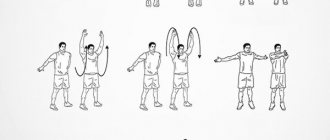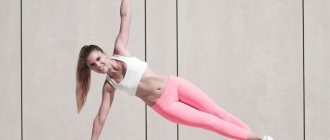Recently, I finally decided to take care of my appearance, and in addition to long walks and reviewing my daily diet, I decided to do simple physical exercises that will help tighten my muscles, and one of these exercises for me was the plank. Therefore, today I will tell you how to do a plank correctly at home, what types of planks there are for weight loss, and what you should pay attention to when performing this exercise.
What does the bar give?
Start doing the exercise every day and seven pleasant changes await you.
Core muscles will become stronger
The dream of many of us is a flat stomach with clearly defined muscle cubes. Developed core muscles provide support for internal organs, allow you to constantly maintain a straight posture, maintain a healthy back and make your waist narrower.
- The plank simultaneously engages all major muscle groups of the core:
- rectus abdominis muscle - responsible for the “pack” and helps to jump better;
- oblique abdominal muscle - responsible for twisting at the waist and the ability to bend sideways;
- back extensors - support and protect the spine, responsible for keeping the back straight;
- gluteus maximus muscle - will create a beautiful profile and support the back.
The core muscles are the only muscles that can be trained while remaining stationary.
Performing the pose will allow you to form a muscle corset without the risk of unnecessary stress on your back and hips.
The condition of the back muscles will improve
Regular planking will strengthen not only your lower body, but also your upper body, which will reduce the risk of back pain.
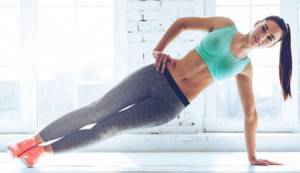
Scientists at Columbia University have proven that regularly performing the side plank reduces pain in osteochondrosis by almost 40%.
Metabolism will speed up
The plank burns more calories than classic abdominal exercises such as crunches and squats. If you do the exercise daily, it will not only ensure a fast metabolism throughout the day, but also improve your overall metabolism (even while you sleep).
Posture will improve
This exercise is a great way to improve your posture. By strengthening the muscles of your neck, shoulders, back and lower back, it will be easier for you to keep your back straight. Once you start doing the plank, people around you will notice your improved posture.
Develop a sense of balance
How long can you stand on one leg? If it’s just a couple of seconds, you urgently need to strengthen your abdominal muscles. A developed sense of balance will help you achieve great results in any sport.
Improved flexibility
Standing in a plank stretches the muscles and ligaments attached to your shoulders, shoulder blades, collarbones, hips, even your toes. The side plank works the obliques and increases flexibility throughout the body.
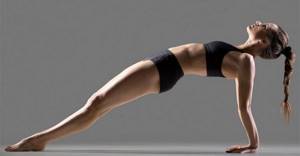
Your psychological state will improve
The plank stretches exactly those muscles that accumulate stress and tension in the body. Doing it daily will improve your mood and have a positive effect on your entire nervous system. This is especially true for office workers who sit almost all day.
Types of planks
The exercise can be diversified by removing the support points (arm or leg) and adding dynamic elements.
Types of planks:
- elbow bar (classic);
- on straight arms;
- with raised hand;
- with a raised leg;
- two points are involved, with the arm and leg of opposite sides raised;
- plank with push-ups;
- with steps;
- with twisting;
- with knee tightening;
- lateral;
- reverse plank.

An exercise that takes less than five minutes to complete can transform your body.
Is it possible to lose weight by doing planks?
The static exercise itself does not produce a fat burning effect and does not reduce weight. With the right approach, this promotes weight loss, since static loads force the body to intensively expend energy reserves, and this means burning calories.
Plank for weight loss before and after photos:

Errors during execution
There are mistakes that not only beginners often make when performing the plank exercise at home. But you definitely need to learn how to do a plank correctly. Because unconsciously a person begins to cheat to make the exercise much easier.
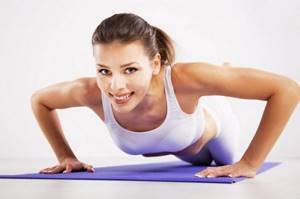
Most often people make the following mistakes:
Incorrect position of the lower back
Please note that it should be smooth and not curved. If your lower back is positioned higher or lower than your torso, then this risks reducing the effectiveness of performing the plank to zero. Looking at the floor
This cannot be done because it puts additional stress on the neck. You need to look ahead of yourself. They breathe slowly or too quickly. This makes the exercise more difficult to perform. You need to focus on breathing evenly and deeply. Take a long break between approaches. It is effective if the breaks between approaches are short. Do exercises irregularly. This is monotonous work that must be done systematically in order to achieve results.
The popularity of the exercise is due to the fact that modern people do not have time to devote a lot of time to sports. And regularly doing the bar, doing it correctly, you can achieve good results.
Exercise for 30 days
When the basic technique completely submits to you, move on to more complicated options.

After a month of active training with short breaks (as seen in the table above), you should increase your endurance from 20 seconds to 5 minutes.
Of course, you won’t be able to achieve an ideal body in a month with just one plank, but in combination with an elementary diet, your body will noticeably tighten and become slimmer.
Contraindications
Like any exercise, even a static one, standing exercises have a number of limitations; more details are written here. It is recommended to refrain from this exercise in the following cases:
- pinched nerve;
- disruption of internal organs;
- presence of intervertebral hernia;
- vertebral displacement;
- pregnancy or postpartum period;
- musculoskeletal injuries.
Your well-being will directly depend on how many times a day you do the plank. Some will be invigorated by several approaches, while for others even one will seem too much. Internal sensations are extremely important, do not do the exercise by force. If you are tired, rest, if you think that one approach is not enough. Your body needs more - you can repeat it.
If you have minor health problems! If your doctor has given you permission to exercise, it is not recommended to do the plank more than once a day.
The question of how much to do this exercise and in what time range is purely individual. Depends on factors such as your well-being, availability of time and the purpose of the exercise. It is recommended to start the stand with 1-2 approaches of 15-30 seconds. Gradually increasing to 3-5 for 5 minutes. The plank should not be performed by force or during periods of poor health. Follow the schedule and do not make mistakes in the exercise, or it will lose its effectiveness.
How to do it right
Many beginners mistakenly believe that the absence of intense dynamic movements greatly simplifies training. However, the plank is actually difficult to perform. Strict adherence to all technical rules guarantees maximum benefit of the exercise for the body.
Did you know? There are from 640 to 850 muscles in the human body. Their number depends on the development of muscle tissue.
The very name “plank” indicates the need to keep your back straight throughout the stance. The placement of the arms and legs depends on the variations of the exercise. Let's take a closer look at the technique of performing each of them.

Classic version on the elbows
Proper training includes the following actions:
- Take a lying position with your legs straight and your arms bent at the elbows, shoulder-width apart.
- Make sure your forearms are pressed against the mat and the curve of each arm is at a right angle. Only brushes can be closed. This will lighten the load, but reduce the effectiveness of the workout.
- Raise your hips and transfer your body weight to your elbows and toes. It is unacceptable for the back to bend or the pelvis to protrude. The spine should remain straight until the end of the stance. Do not arch your lower back and keep your head straight.
- Hold this position motionless for a certain time. For beginners, 20-30 seconds are recommended, and for trained men - 10-20 minutes.
- Tighten the muscles of your hips and buttocks. This will reduce the spinal load. Breathe evenly.

On outstretched arms
This is a complicated form of the classic plank.
Important! For immediate effectiveness, it is recommended to do the plank daily in 2-3 approaches, gradually increasing the time of the stand.
To implement it:
- Take a lying position, resting on your palms. Your arms must be kept straight. For convenience, it is recommended not to place them too close to each other.
- Raise your hips and focus on your toes.
- Make sure that your back does not arch and your posture resembles a string.
- Try to maintain the stance as much as possible.

On the knees
This type of training is very suitable for people with weak muscles. If you can’t do the classic and other more complex plank variations, try this.
The rules for this stance technique are simple:
- Kneel down with your knees shoulder-width apart.
- Take a lying position, leaning on bent or straightened arms (do it as you feel comfortable until you practice). The legs remain bent. The ankles can be crossed or closed.
- Keep your head in line with your body, do not raise it too high. Breathe evenly.
- Try to hold the stance for as long as possible.
Superman plank
This stance is the most complicated form of plank and is in many ways reminiscent of yoga asanas.
Did you know? The world record for the longest plank hold belongs to a Chinese policeman who was able to hold the plank for 8 hours and 1 minute without moving. Second place went to an American Marine who stood in the same position for 7 hours and 40 minutes.
For it you will need:
- Take the starting position using the plank principle with your arms outstretched.
- Raise your hips, keeping your back and pelvis in one straight line.
- Lift your left arm off the floor and, straightening it, extend it in front of you.
- At the same time, lift your right leg off the floor, pointing it backward. Thus, the body emphasis should be on the right palm and left toe.
- After maintaining this position for several minutes, repeat the same actions with the other arm and leg.

Lateral
It is one of the complex types. Recommended for men who can withstand the classic version for several minutes.
Find out if planking helps you lose weight.
For this variation you need:
- Lie on your side, resting on your elbow and the side of your foot.
- Raise your second hand up, keeping it in line with the first.
- Place your feet parallel to each other.
- Straighten your back, lift your pelvis. Breathe evenly.
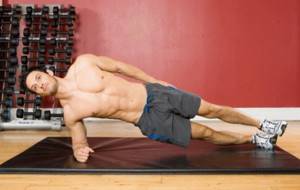
Reverse plank
Requires:
- Sit on the floor.
- Tilt your torso back at an angle of 45° and lean on your hands placed behind your buttocks. They should be positioned exactly shoulder width apart. In this case, it is advisable to spread the fingers of the palms widely, which will ease the tension.
- Straighten your legs.
- Raise your buttocks, focusing on your feet. Your ankles, front thighs and stomach should be in one line.
- Tighten your abdominal muscles and try to stay in this position for as long as possible.





